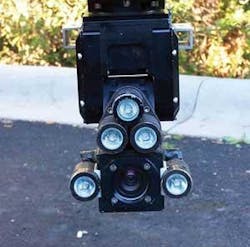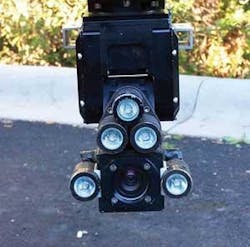Project Restores River Flow, Provides Water Supply
The American River descends from the crest of the Sierra Nevada Mountains near Lake Tahoe to join the Sacramento River near downtown Sacramento. The Auburn Dam project on the North Fork of the American River started in the mid-1960s resulted in the dewatering of approximately a one-mile reach of the river near the town of Auburn. The local water provider’s intake and pump station were removed to accommodate dam construction activities. In the late 1970s, seismic, environmental, and cost sharing concerns halted construction on the project. WHPacific was retained to design both the restoration of this river reach and an innovative permanent water diversion facility for the local water provider.
Congress authorized the U.S. Bureau of Reclamation (USBR) to construct the Auburn Dam on the North Fork of the American River in 1965. Construction began on a 33-foot diameter tunnel to divert the river around the dam construction site in 1968. In 1975, a 265-foot-high temporary earth fill dam (cofferdam) was completed which forced the river into the recently completed diversion tunnel. This action dewatered an approximate one-mile reach of the river. A large water intake and pump station owned by Placer County Water Agency (PCWA) were removed as part of the project and USBR began providing water to PCWA with temporary intake, pump and piping facilities.
That same year, an earthquake occurred near Oroville, CA, about 50 miles north of the dam site. This raised concerns about the seismic nature of the fault systems that exist along the foothills of the Sierra Nevada mountain range near the dam site. Construction on the dam was temporarily halted as USBR re-evaluated the seismicity of the site and implications for the proposed dam. Environmental and cost-sharing concerns caused further delays. In 1986, record flood flows overtopped and breached the cofferdam depositing an estimated two million cubic yards of rock and debris into the river reach below, dramatically altering it.
Following the failure of the original cofferdam, a much smaller temporary dam was constructed to raise river levels enough to facilitate diversions to the temporary pumping system. This cofferdam was overtopped fairly regularly by high river flows which continued to erode significant amounts of rock and sediment from the dam and deposit it downstream.
By the mid 1990s, Placer County had become one of the fastest growing areas in the nation and the temporary pumping facilities provided by USBR for the past 20 years were no longer adequate to meet year-round demands. The temporary system had limited flow capacity and had to be removed each year to protect it from winter floods. Vulnerability to floods, high costs and inability to meet demand led PCWA and the Federal government to begin investigating alternatives for a new permanent diversion structure and pumping plant.
Design Implementation
WHPacific was part of the project team from a very early stage, helping to evaluate alternatives for restoring the river through the dam site and provide a permanent, reliable diversion facility. The design was complicated by the presence of the massive cofferdam remnant and downstream deposits of debris from its failure. Combined, these factors created very aggressive hydraulic conditions on an unstable river bed. Complete removal of the cofferdam remnant and debris from its failure were not feasible financially. Ultimately a plan was developed that combined limited re-grading of the cofferdam remnant with grade stabilizing structures in the river.
A permanent and reliable water supply intake was designed that would withstand heavy sediment loads and provide the desired capacity including future expansion. This intake also meets environmental requirements related to fish exclusion and bypass flows and allows fish and boat passage through the newly restored river reach. The owner required that the design use tilted, wedge-wire river screens, mounted in the bottom of the river in a boat passable structure.
Design of the intake structure and rehabilitation of the overall river reach was aided by two separate physical models, one built and operated by Colorado State University (CSU) in Fort Collins and the other at USBR’s Hydraulics Laboratory in Denver. The full-scale, unit width model of the screens constructed by CSU was used to evaluate diversion capacity, sediment plugging tendencies and air-backwash effectiveness. A much larger scale model of the river reach by USBR was used to evaluate options for cofferdam regrading and overall reach geometry, and sediment transport characteristics.
The two physical models were complimented by computer-based numerical modeling using the BriStars sediment transport model and Flow3D, a computer-based three-dimensional hydraulic model. BriStars was used to evaluate both local and reach scale sediment movement for single event and long-term hydrology. Flow3D was used on a macro-scale to design a boatable bypass channel of naturalistic chutes and pools and to track sediment movement to assist in the design of sediment control structures. Flow3D was also used on a micro-scale to evaluate flow patterns and sediment movement through the intake screens.
Finished Product
Construction of the American River Intake Structure and channel were completed in late 2007. The bypass tunnel has been sealed and the river once again flows through the site. Revegetation will take several years and evidence of the dam project which started more than 40 years ago will always be visible. In place of the dam now stands a unique multi-use diversion facility that provides not only a reliable water supply but also provides for bypass of environmental base flows, fish and boat passage and whitewater recreation. The restored river enhances the appearance of the scarred dam construction site and new public access facilities open the area to recreation.WW
About the Authors: George Slovensky is a senior project engineer with WHPacific. and is based in the firm’s Lakewood, CO, office. He may be contacted at [email protected]. WHPacific, Inc. (www.whpacific.com) is owned by NANA Development Corp. of Anchorage, Alaska. The company provides a broad range of services including engineering, architecture, surveying and planning to commercial and governmental clients nationwide. Alan Stroppini is Design Branch Chief of the Mid-Pacific Regional Office of the USBR in Sacramento, CA.
Circle No. 295 on Reader Service Card


